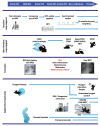The Intertemporal Role of Respiratory Support in Improving Neonatal Outcomes: A Narrative Review
- PMID: 34682148
- PMCID: PMC8535019
- DOI: 10.3390/children8100883
The Intertemporal Role of Respiratory Support in Improving Neonatal Outcomes: A Narrative Review
Abstract
Defining improvements in healthcare can be challenging due to the need to assess multiple outcomes and measures. In neonates, although progress in respiratory support has been a key factor in improving survival, the same degree of improvement has not been documented in certain outcomes, such as bronchopulmonary dysplasia. By exploring the evolution of neonatal respiratory care over the last 60 years, this review highlights not only the scientific advances that occurred with the application of invasive mechanical ventilation but also the weakness of the existing knowledge. The contributing role of non-invasive ventilation and less-invasive surfactant administration methods as well as of certain pharmacological therapies is also discussed. Moreover, we analyze the cost-benefit of neonatal care-respiratory support and present future challenges and perspectives.
Keywords: bronchopulmonary dysplasia; mechanical ventilation; neonate; non-invasive ventilation; outcome; prematurity; respiratory distress.
Conflict of interest statement
The authors declare no conflict of interest.
Figures

Similar articles
-
The future of Cochrane Neonatal.Early Hum Dev. 2020 Nov;150:105191. doi: 10.1016/j.earlhumdev.2020.105191. Epub 2020 Sep 12. Early Hum Dev. 2020. PMID: 33036834
-
Respiratory management in the premature neonate.Expert Rev Respir Med. 2023 Feb;17(2):155-170. doi: 10.1080/17476348.2023.2183843. Epub 2023 Mar 2. Expert Rev Respir Med. 2023. PMID: 36803028 Review.
-
The influence of the technique of surfactant administration (LISA vs INSURE) on the outcomes of respiratory distress syndrome treatment in preterm infants.Dev Period Med. 2019;23(3):163-171. doi: 10.34763/devperiodmed.20192303.163171. Dev Period Med. 2019. PMID: 31654994 Free PMC article.
-
Effects of less invasive surfactant administration versus intubation-surfactant-extubation on bronchopulmonary dysplasia in preterm infants with respiratory distress syndrome: a single-center, retrospective study from China.BMC Pulm Med. 2022 Dec 5;22(1):462. doi: 10.1186/s12890-022-02270-x. BMC Pulm Med. 2022. PMID: 36471386 Free PMC article.
-
Minimally invasive surfactant administration in preterm infants: a meta-narrative review.JAMA Pediatr. 2014 Oct;168(10):901-8. doi: 10.1001/jamapediatrics.2014.1148. JAMA Pediatr. 2014. PMID: 25089718 Review.
Cited by
-
A Survey on the Organization and Operation of Level II/III Neonatal Intensive Care Units in Greece: A Comparison Between 2004 and 2022.Children (Basel). 2025 Jan 13;12(1):85. doi: 10.3390/children12010085. Children (Basel). 2025. PMID: 39857916 Free PMC article.
-
Incidence of nasal pressure injury in preterm infants on nasal mask noninvasive ventilation.Rev Paul Pediatr. 2023 Mar 13;41:e2022093. doi: 10.1590/1984-0462/2023/41/2022093. eCollection 2023. Rev Paul Pediatr. 2023. PMID: 36921179 Free PMC article.
-
Management of respiratory distress in moderate and late preterm infants: clinical trajectories in the Neobs study.Eur J Pediatr. 2023 Dec;182(12):5661-5672. doi: 10.1007/s00431-023-05259-8. Epub 2023 Oct 12. Eur J Pediatr. 2023. PMID: 37823928 Free PMC article.
References
-
- Philip A.G.S. Historical Perspectives: Forty Years of Mechanical Ventilation …Then and Now…. NeoReviews. 2003;4:e335–e339. doi: 10.1542/neo.4-12-e335. - DOI
Publication types
LinkOut - more resources
Full Text Sources

